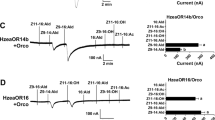Abstract
Ostrinia furnacalis, a lepidopteran moth, is an invasive pest found in Asia, Australia, Africa, and parts of the United States. The O. furnacalis pheromone-binding protein2 (OfurPBP2), present in the male moth antenna, plays a role in the detection of female-secreted pheromone in a process that leads to mating. To understand the structural mechanism of pheromone binding and release in this pest, we have initiated characterization of OfurPBP2 by solution NMR. Here, we report the backbone resonance assignments and the secondary structural elements of OfurPBP2 at pH 6.5 using uniformly 13C, 15N-labeled protein with various triple resonance NMR experiments. The assignments are 97% completed for backbone and 88% completed for side-chain resonances. The secondary structure of OfurPBP2, based on backbone chemical shifts, consists of eight α-helices, including a well-structured C-terminal helix.



Similar content being viewed by others
References
Damberger F et al (2000) NMR characterization of a pH-dependent equilibrium between two folded solution conformations of the pheromone-binding protein from Bombyx mori. Protein Sci 9(5):1038–1041
Damberger FF et al (2007) Structural basis of ligand binding and release in insect pheromone-binding proteins: NMR structure of Antheraea polyphemus PBP1 at pH 4.5. J Mol Biol 373(4):811–819
Delaglio F et al (1995) NMRPipe: a multidimensional spectral processing system based on UNIX pipes. J Biomol NMR 6(3):277–293
Fernandez EC et al (2006) Survey of alternate host plants of Asian corn borer (Ostrinia furnacalis (Guenée)) in major corn production areas of the Philippines. Asian Int J Life Sci 15
di Luccio E et al (2013) Crystallographic observation of pH-induced conformational changes in the Amyelois transitella pheromone-binding protein AtraPBP1. PLoS ONE 8(2):e53840–e53840
Horst R et al (2001a) NMR structure reveals intramolecular regulation mechanism for pheromone binding and release. Proc Natl Acad Sci USA 98(25):14374–14379
Horst R et al (2001b) Letter to the editor: NMR assignment of the A form of the pheromone-binding protein of Bombyx mori. J Biomol NMR 19(1):79–80
Katre UV et al (2009) Ligand binding turns moth pheromone-binding protein into a pH sensor: effect on the Antheraea polyphemus PBP1 conformation. J Biol Chem 284(46):32167–32177
Katre UV et al (2013) Structural insights into the ligand binding and releasing mechanism of Antheraea polyphemus pheromone-binding protein 1: role of the C-terminal tail. Biochemistry 52(6):1037–1044
Kowcun A et al (2001) Olfaction in the gypsy moth, Lymantria dispar: effect of pH, ionic strength, and reductants on pheromone transport by pheromone-binding proteins. J Biol Chem 276(48):44770–44776
Lee D et al (2002) NMR structure of the unliganded Bombyx mori pheromone-binding protein at physiological pH. FEBS Lett 531(2):314–318
Lee W et al (2015) NMRFAM-SPARKY: enhanced software for biomolecular NMR spectroscopy. Bioinformatics 31(8):1325–1327
Mazumder S et al (2018) Structure and function studies of Asian corn borer Ostrinia furnacalis pheromone binding protein2. Sci Rep 8(1):17105
Mohanty S et al (2003) 1H, 13C and 15N backbone assignments of the pheromone binding protein from the silk moth Antheraea polyphemus (ApolPBP). J Biomol NMR 27(4):393–394
Mohanty S et al (2004) The solution NMR structure of Antheraea polyphemus PBP provides new insight into pheromone recognition by pheromone-binding proteins. J Mol Biol 337(2):443–451
Nafus et al (1991) Review of the biology and control of the Asian corn borer, Ostrinia furnacalis (Lep: Pyralidae). Trop Pest Manag 37:41–56
Shen Y et al (2009) TALOS+: a hybrid method for predicting protein backbone torsion angles from NMR chemical shifts. J Biomol NMR 44(4):213–223
Wishart DS et al (1995) 1H, 13C and 15N random coil NMR chemical shifts of the common amino acids. I. Investigations of nearest-neighbor effects. J Biomol NMR 5(1):67–81
Xu W et al (2011) Extrusion of the C-terminal helix in navel orangeworm moth pheromone-binding protein (AtraPBP1) controls pheromone binding. Biochem Biophys Res Commun 404(1):335–338
Xu X et al (2010) NMR structure of navel orangeworm moth pheromone-binding protein (AtraPBP1): implications for pH-sensitive pheromone detection. Biochemistry 49(7):1469–1476
Zubkov S et al (2005) Structural consequences of the pH-induced conformational switch in Antheraea polyphemus pheromone-binding protein: mechanisms of ligand release. J Mol Biol 354(5):1081–1090
Acknowledgements
This research was financially supported by National Science Foundation Award CHE-1807722 to Smita Mohanty. We thank Dr. David Zoetewey for numerous useful discussions. All NMR data were collected at the National High Magnetic Field Laboratory, which is supported by National Science Foundation Cooperative Agreement No. DMR-1644779 and the State of Florida. We thank Dr. Thomas Webb of Auburn University for the critical reading of this manuscript.
Author information
Authors and Affiliations
Contributions
SM conceived, designed the strategies and techniques employed, supervised the research, and analyzed the data. SD and BC conducted NMR experiments. SD and JL processed and analyzed NMR data and completed the NMR resonance assignments. SM and SD wrote the paper and SD and JL prepared figures.
Corresponding author
Ethics declarations
Conflict of interest
The authors declare that they have no conflict of interest with the contents of this article.
Additional information
Publisher's Note
Springer Nature remains neutral with regard to jurisdictional claims in published maps and institutional affiliations.
Rights and permissions
About this article
Cite this article
Dahal, S.R., Lewellen, J.L., Chaudhary, B.P. et al. 1H, 13C, and 15N resonance assignment and secondary structure of the pheromone-binding protein2 from the agricultural pest Ostrinia furnacalis (OfurPBP2). Biomol NMR Assign 14, 115–118 (2020). https://doi.org/10.1007/s12104-020-09930-1
Received:
Accepted:
Published:
Issue Date:
DOI: https://doi.org/10.1007/s12104-020-09930-1




